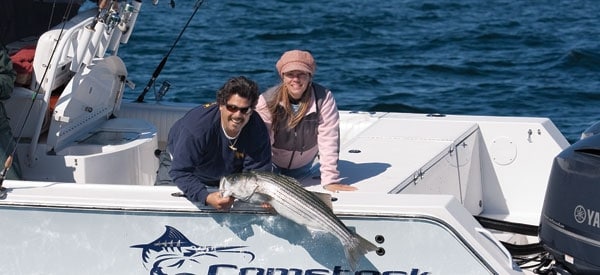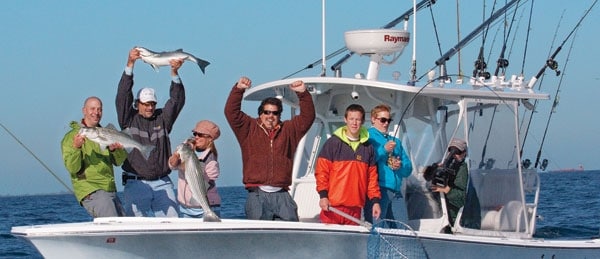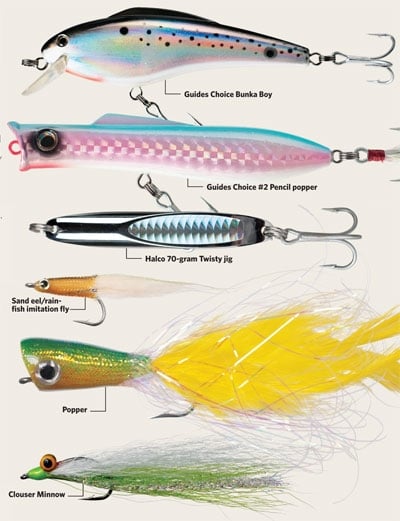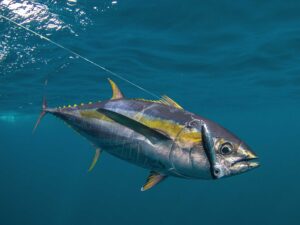
From the Chelsea Piers, on Manhattan, we ran down the Hudson River, under the Verrazano-Narrows Bridge and east past Coney Island, struggling to keep up with Capt. Frank Crescitelli’s Fin Chaser. He carried the VIPs for the FCA Manhattan Cup, the Fisherman’s Conservation Association’s annual tournament, threading through the fleet, dropping off plane just long enough to get his anglers hooked up. He was working the birds and the fast-moving schools of striped bass under them. We were following, hoping to get some video of the action. No sooner did we locate and approach his boat, which consistently had anglers fighting fish from both sides, than he landed the fish, jumped on plane and took off once again. It was the kind of run-and-gun action that we’d enjoy for the better part of the next two days.
Annual Rendezvous
Every spring, beginning in April, these waters at the mouth of the Hudson River fill up with bunker, bay anchovies, sand eels and, as expected, a tremendous number of striped bass.
“The run starts in early April,” Crescitelli says. “Then it peaks in May as the fish move up the river, then peaks again in June when the fish come back down.” Crescitelli makes a good business chasing stripers with plugs and flies, which they hit readily in these 20- to 50-foot depths. But that’s not the only way to target them.
Capt. Steve Byrne of First Cast Charters prefers live-baiting. “Big menhaden are the indicator,” he says. “They show up around St. Patrick’s Day. Then the big bass get on them by the first of April. And it really gets cranking by May 1.”
Once the fish are in and feeding on the bunker, the fishing is consistent to say the least, Byrne says: “Last year it was insane with fish. We’d put a live bunker in the water, and we’d have 30-pounders tripping over each other to get to it. It was like that for a month.”
Byrne’s bunker rig is simple. He uses conventional tackle with 20- to 30-pound mono, a 60-pound leader and an 8/0 hook. He hooks the bunker through the nostrils and then drops it back into a school. “Put the reel in free-spool with the clicker on and with your thumb on the spool; let it swim naturally,” he says. “When the bass come after the bunker, yours is just a little slower than the rest, and he’ll get drilled.”
Just like the technique, locating the stripers is simple, Byrne says. He cruises until he sees surface activity or until the fish finder lights up. “When they are not crashing the bait,” he says, “I drive around until I see something on the fish finder, then go back over it and put a bait out.” Usually the fish come up readily, even when they are lying 20 or 30 feet down. “If they don’t, I put a sinker on and drop it down to them.”

Artificial Paradise
The largest fish usually come on natural bait, but one of the spectacular features of this fishery is the willingness of these stripers to hit artificials and flies. For the two days I spent with Crescitelli, we threw nothing but artificials – small diamond jigs, plugs, plastic-tailed jigs and streamer flies – and they all produced stripers right around the 35-inch mark. While there are bigger fish to be had, these are nothing to overlook - stripers scaling from 15 on up to 25 pounds are plenty sporty on light tackle.
The preferred method is to stay on the move, and finding the birds is the ticket. When the bass were messing up the bait, birds tipped off the action, but it was often fast-moving and we had to be ready to follow the fish or find another active school.
Because striper fishing is not allowed in federal waters – beyond three miles from shore – our hunting was limited. Within those bounds, in 20 to 50 feet of water, we found continuous action as long as the water temperature remained above 50 degrees. When we hit cooler water, the action fell off. Likewise, when the tide turned in the mid-afternoon and began coming in, the cooler water from offshore made the fish tougher to find, and the action slowed.
With the range of artificials we fished, the stripers demanded a lure that only somewhat mimicked their natural forage, and that’s about as picky as they got. Jigs cast far and then worked back deep produced consistently, and streamer flies, such as Lefty’s Deceiver or anything that looked fishy, cast on 400-grain 10-weight sinking lines seemed to trump even the lures.
It takes a bit of cooperation, but two anglers who remain aware of each other can easily fly-cast from the bow of a center console. The technique is simple: Cast far, let the line sink, then strip steadily to activate the fly while keeping it deep for as long as possible. When the fish are on, you’d have a tough time finding better action anywhere for fly-rod and light-tackle stripers.
Gathering Up Livies
Menhaden, locally referred to as bunker, are the live bait of choice for striper fishermen working the mouth of the Hudson and Raritan Bay and the nearshore waters of New York and New Jersey. Beginning in April, bunker concentrate in dense schools and can be easily cast-netted. A 10-foot cast net (20-foot diameter) works best, but the baits are thick enough that any size net will do the job. Old Orchard Lighthouse, in Great Kills Harbor on the east side of Staten Island, is a favorite bait-gathering spot for those in the know; last year the bunker were thick at Romer Shoals, 2 12 miles north of Sandy Hook. Wherever you find them bunched up, you should be able to fill a livewell with one throw of the net or collect enough with a snatch hook in very little time if cast-netting is not part of your skill set. Look for rippling on the surface of the water or giant red blotches on the fish-finder screen, fill up the livewell and head on out.
NYC Stripers

From Coney Island on to Breezy Point and the Rockaways, out in front of Fort Tilden and east to Riis Park, this spring run of striped bass offers a long season of reliable fishing. Be warned, however: It’s a fishery that is restricted to state waters, within three miles of shore, in New York and New Jersey. Striper fishing is prohibited in federal waters. From Great Kills, on Staten Island, across the mouth of the Hudson and down along the outside of Long Island, pods of bunker (menhaden), rainfish (bay anchovies) and sand eels draw stripers heading up the Hudson River to spawn in May and return in June. They are hungry going both ways and great targets for artificial lures and flies, as well as natural baits.
What: Striped bass.
When: April through June.
Where: Mouth of the Hudson River, off the beach from Coney Island east in New York state waters, within three miles of shore.
Who: Whether you prefer live-baiting, lures or fly-fishing, these captains can put you on the striper run.
Capt. Frank Crescitelli
Fin Chaser Charters
718-317-1481
www.finchaser.com
Capt. Brendan McCarthy
Urban Fly Guides
917-847-9576
www.urbanflyguides.com
Capt. Steve Byrne
First Cast Charters
347-452-3796
www.firstcastfishing.com
Expect most of the fish you catch during the spring run to tape in the 34- to 36-inch range. They may be heading up the Hudson or coming back down: The presence of sea lice is a good indication that the fish have not yet entered the fresh water of the river. In New York, a saltwater license is required unless you fish aboard a charter boat. Striped bass limits: charter boats, two fish, 28-inch minimum, April 15 through Dec. 15; all others, one fish 28 to 40 inches and one fish over 40 inches, April 15 through Dec. 15. In New Jersey, no license is required, but free registration at state.nj.us is mandatory. Limit: two fish 28 inches or greater and a third fish with state-issued bonus card: See state.nj.us/dep/fgw.
Rods: Conventional, spinning rods to cast medium lures, plugs and spoons on 20-pound line and fight fish to 40 pounds. Fly-fishing: 9-foot 10-weight.
Reels: To match rods.
Lines: 15- to 20-pound mono, 40- to 60-pound fluoro leaders. Fly-fishing: 10-weight outfits; 400-grain sinking lines; 12-, 16- and 20-pound tippets.
Lures: Various metals, swimming plugs, chuggers, streamer flies.










